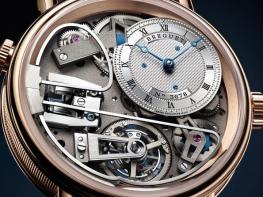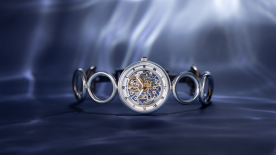Whatever innovations have appeared in recent years, the minute repeaters has remained firmly based on a principle introduced in the 18th century: a hammer strikes a metal ring that vibrates and creates a sound. This gong is wrapped around the movement and the hammer strikes it from the side. Breguet has now entirely rethought this principle with the Tradition Répétition Minutes Tourbillon 7087.
The devil is in the details when it comes to minute repeaters. The only horological complication that steadfastly resists any attempts at “democratisation”, it is interpreted in dozens of different ways by dozens of brands, with very few managing to really stand out from the crowd. Nonetheless, some of them, whether by dint of technical knowledge or experience, have significantly contributed to the science of musical watches in recent years. Breguet had already made discreet advances in its various models, but it took 12 years of background research and five years of specific development to launch the 7087, which incorporates these numerous changes in a resolutely pragmatic manner.

The first significant change lies in the fact that the hammers of Calibre 565DR strike the gongs vertically rather than horizontally. Instead of protruding beyond the side of the movement, they strike from beneath, like someone hitting the ceiling to complain about noisy neighbours. Behind this change of angle lies a physical observation: the bezel and the bezel generate sound like the membrane of a loudspeaker. To set them into vibration, like a piston, it is more efficient for the energy to arrive in the same direction as the vibration. Since the surface of the glass is flat, the vibration should arrive on a flat plane.
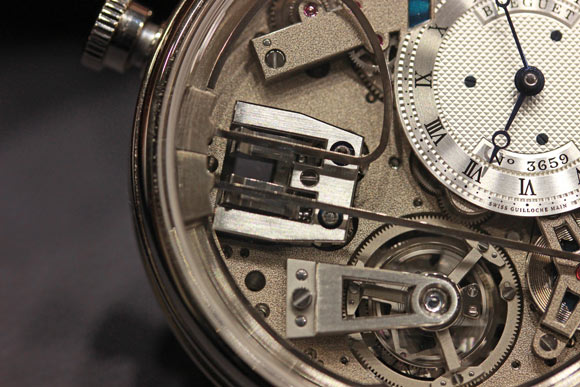
Representing a second shift in the approach, the vibration of the watch is considered as an indivisible whole. The gong in itself does not produce any sound. It is fixed to the bezel and thus to the sapphire crystal, which are the elements that produce the music in coordination with the case. The bezel is thus secured to the bezel at three points, chosen for their position conducive to propagating the sound. The case itself has been reworked in order to increase it. Its back is pierced with several perforations, using the principle of Helmholtz resonance. Behind this complex name lies the well-known phenomenon that produces a sound by blowing into the neck of an empty bottle: with the right angle and the right volume, the cavity captures a vibration and yields a note. This is the most basic form of natural amplification.
The third fundamental element is the gongs, with their astonishing unprecedented shape. Both are folded over the movement instead of coiled around it. They are also shorter than usual. The first, pointing upwards and shaped like a sugar loaf, is shorter and produces the high-pitched minutes note. It is fixed to the bezel by its two ends, which would be complete nonsense in a classic minute repeater system. The second features an irregular shape, something like a large D with a ‘kiss curl’ half-way along the large loop. It is secured by one end only. The approach that resulted in these intriguing shapes is entirely novel.
Breguet actually the desired sound as the starting point and designed the gongs accordingly. The developers are now able to conceive the geometry according to the desired effect rather than the other way around. Another novel feature is the fact that the gongs are made of gold rather than the traditional steel. There is no esoteric formula, no secret hardening process or fairydust here: it’s a standard gold alloy. What the team discovered is that filtering the sound through the case and the glass is more important than the sound produced by the metal of the gong. They therefore chose gold because it serves to activate more sound frequencies within the audible spectrum, thereby creating a richer sound. It also helps maintain continuity between the case, bezel and gong, since they are all made of the same material.
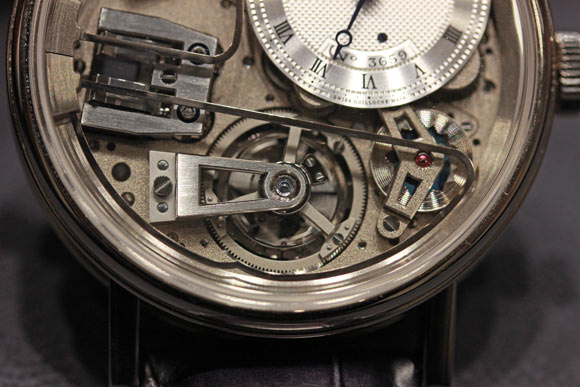
The fourth new feature is the governor, which regulates the speed at which the striking mechanism unwinds. A minute repeater operates via a small barrel, which is wound when the slidepiece is activated or the striking button is pressed. Like any spring, it naturally uncoils extremely rapidly and must be restrained. Instead of mechanical means that are always audible and disturb the sound of the gongs, Breguet has leveraged the experience acquired with its Réveil Musical watch. The brand uses the latter’s magnetic governor, of which the rotation speed is filtered by magnets. This totally silent system can only operate because of the presence of a 100% silicon escapement that is impervious to magnetic fields. A traditional escapement contains iron and would have seriously perturbed the mechanism. The result is no friction and no noise, giving the striking mechanism complete freedom to occupy the available sound space.
The fifth innovation is the transmission of the force, an important detail. Striking mechanisms are often presented to the public by having them chime for as long as possible, at 12 hours and 59 minutes. This tends to reveal that the hammers do not strike with regular force. The last notes tend to peter out due to lack of energy, whereas the first are too intense. Breguet uses a transmission system via a chain coupled with a cam. It equals out the force of the approximately 20-second-long chime.
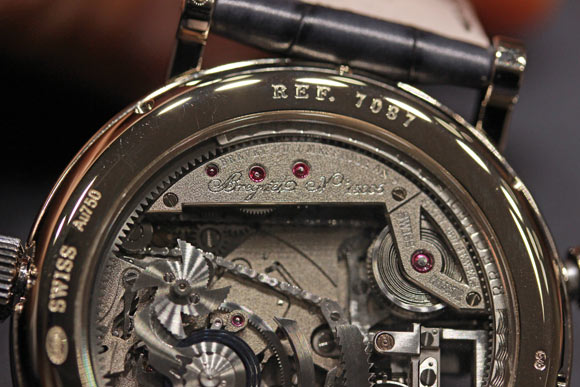
Two last points before concluding, since the Tradition Répétition Minutes Tourbillon is not merely a striking watch. It is also one of the rare models to boast automatic winding, performed by a platinum segment that turns around the movement. This peripheral weight does not obstruct the view of the back of the 565DR movement. In this respect, it is entirely in tune with the logic of the Tradition line, which displays its entire architecture from both sides. Energy, materials, the transmission of force and sounds, natural amplification: Breguet took five years to create the 7087. From both front and back, the novelty of the approach is visible at first glance. It is pragmatic, profound and liable to find a wealth of further audible applications.

